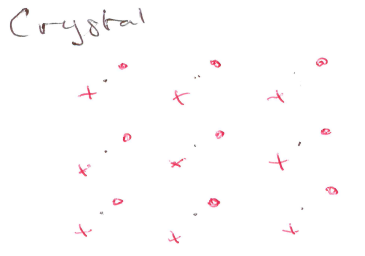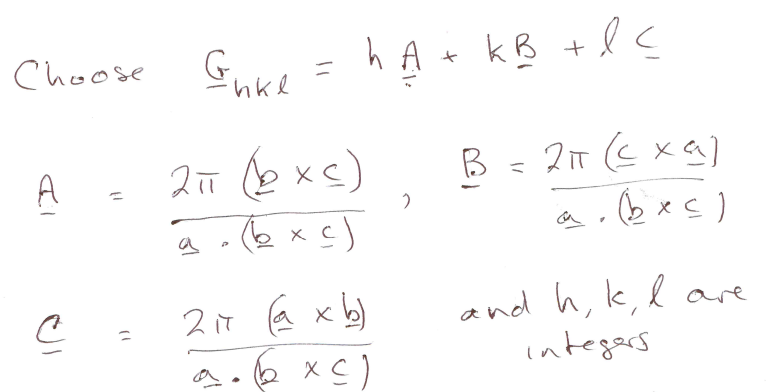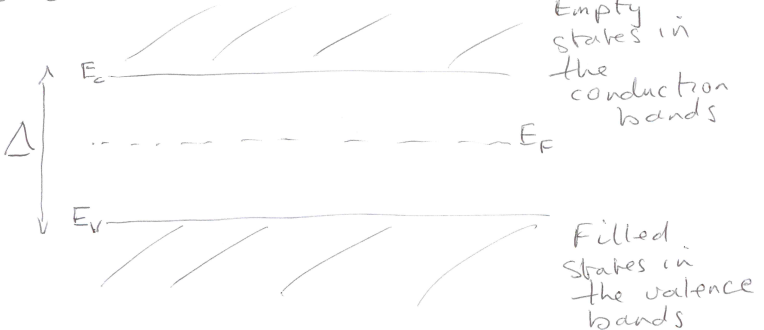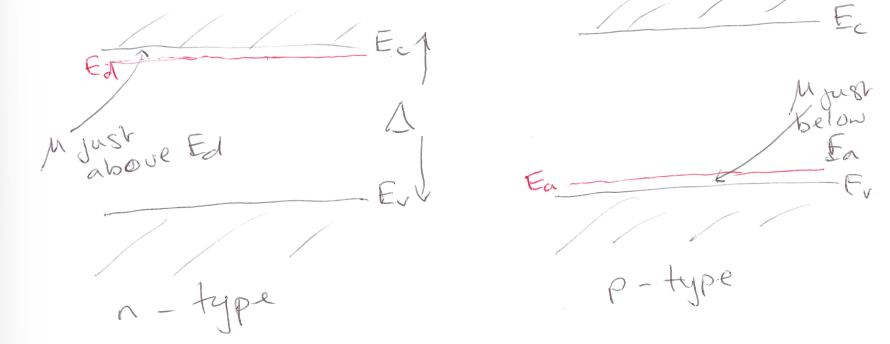Quantum Mechanics term 2
1/72
There's no tags or description
Looks like no tags are added yet.
Name | Mastery | Learn | Test | Matching | Spaced |
|---|
No study sessions yet.
73 Terms
Current flow through a surface in 1 dimension
\frac{\partial j}{\partial x}=-\frac{\partial\rho}{\partial t}
Swapping coordinates of two identical particles
symmetric if bosons
antisymmetric if fermions
Free electron (loosely bound valence electrons) model of a metal
non-interacting fermions
moving in potential from uniform +ve charged background
system neutral
Fermi wavenumber
k_{F}=\frac{N\pi}{2L}
the radius of the Fermi Sphere
Fermi Energy
E_{F}={{\displaystyle}}\frac{{{\displaystyle\hbar}}}{2m}\left(\frac{3\pi^2N}{V}\right)^{\frac23}
Highest energy state occupied by fermions at absolute zero
Density of states
n\left(E\right)=\frac{L}{\pi}\left(\frac{2m_{e}}{{{{{\displaystyle\hbar}}}}^2}\right)^{\frac12}\frac{1}{\sqrt{E}}

Where do allowed states sit?
on a grid in wavevector space
Fermi velocity
group velocity of wavepacket with wavevector grouped around the fermi wavevector

Fermi-dirac distribution
f\left(E,\mu,T\right)=\frac{1}{\exp\left(\frac{E-\mu}{k_{B}T}\right)-1}
Heat capacity
C_{V}=\frac{dE_{tot}}{dT}
Magnetic susceptibility
\chi=\frac{dM}{dB}=\mu_{B}^2n\left(E_{F}\right)
spherical approximation of nuclei
scattering experiments show nucleus can be modelled as sphere with radius R0A1/3
Neutrons and protons key facts
fermions
magnetic moments
interact with magnetic fields
Nuclear binding energy
energy required to break a nucleus into its constituent protons and neutrons
Characteristics of the strong nuclear force
independent of charge
short range (~fm)
Nuclear matter constant density and constant binding energy per nucleon (roughly)
Liquid drop model of nuclei
treats nucleus as a droplet of incompressible nuclear material
Term 1 of binding energy of a nucleus from LDM
C_1A
nuclear interactions show saturation
C1 extracted from data
Term 2 of binding energy of a nucleus from LDM
nucleons on surface are less tightly bound than those in interior
negative term

Term 3 of binding energy of a nucleus from LDM
-\frac{C_3Z\left(Z-1\right)}{A^{\frac13}}
Each proton repels the other
negative term
Term 4 of binding energy of a nucleus from LDM
-\frac{C_4\left(N-Z\right)^2}{A}
nuclei need balance between energies of neutrons and protons
N ~ Z for small nuclei
N just larger than Z for larger nuclei
negative term
Term 5 of binding energy of a nucleus from LDM
C_5A^{-\frac43}
nuclear forces favour pairing of p and n
positive term if Z and N are even
negative if both are odd
zero otherwise

Pauli exclusion principle
fermions cannot occupy the same state in space unless they have different spin states
Guidelines for electronic configurations
fill up Z H-like energy states, labelled n, l, ml and ↑↓
for each n, there are n subshells labelled by increasing l from l = 0 (s,p,d,f)
each subshell labelled by l takes up to 2 x (2l +1) electrons
Which subshells are close in energy?
3d, 4s
4d, 5s
5d, 6s
Which subshell is filled first? 4f or 6s
6s
Molecule modelling
neglect kinetic energy of nuclei and solve electronic problem
nuclei take positions that minimise electronic and nuclear coulomb energy
Density Functional Theory
takes many electron problem and external influence from static nuclei
focusses on dealing with electron charge density
perfect crystal lattice
generated by taking all points in a lattice with the same basis

Position vector describing a lattice
\underline{R}=n_1\underline{a}+n_2\underline{b}+n_3\underline{c}
a b c non-coplanar vectors - the primitive vectors
n1, n2, n3 range over all integer values (+ve and -ve)
Volume of the parallelopiped that describes a unit cell of a 3D lattice
V_{c}=\underline{a}\cdot\left(\underline{b}\times\underline{c}\right)
packing unit cells together fills all space
Bravais lattices
14 3d crystal structures with different symmetries
7 groups of Bravais lattices
cubic
tetragonal
orthorhombic
hexagonal
trigonal
monoclinic
triclinic
Wigner-Seitz cell
the space enclosed by the planes that bisect and are perpendicular to vectors connecting a point to its nearest neighbours
constructed around a single point

Reciprocal lattice use
Determining structure of crystals using X-ray diffraction that probe the reciprocal lattice
Position vector for a reciprocal lattice and its coefficients

Brillouin Zone
Wigner-Seitz unit cell for reciprocal lattice
constructed the same way as actual lattice
contains values of the wavenumber k
Condition on symmetry of potential describing electron interaction with other electrons and nuclei in a crystal symmetry
must be the same symmetry as the lattice
Insulator condition
energy gaps open up in potential
if fermi energy lies in a gap, the system is an insulator
energy gap > 2eV

Bloch theorem
For an electron moving in a periodic potential the Schrödinger wave equation must have solutions of the form \phi_{n,k}\left(\underline{r})=e^{i\underline{k}\cdot\underline{r}}u_{n,k}\left(\underline{r}\right)\right. , where u_{n,k}\left(\underline{r}\right) is a periodic function and e^{i\underline{k}\cdot\underline{r}} is a plane wave
Other insulator material facts
specific heat has no electronic contribution for k_{B}T<\Delta
material transparent for \frac{hc}{\lambda}<\Delta
Condition for semi-conductor
\Delta\le2eV
Semiconductor diagram

Semiconductor doping and why it is done
impurities added to donate 1 electron to conductance band or remove one electron from valence band
allows for easier conduction
Difference between p-type and n-type semiconductors
the position of the chemical potential
in n type, chemical potential just above Ed
in p type, just below Ea

n-type semiconductors
majority carriers - electrons
minority carriers - holes
n-type semiconductors
majority carriers - holes
minority carriers - electrons
Current from a p-n junction
I=i_{s}\left(\exp\left(\frac{eV_{applied}}{k_{B}T}\right)-1\right) where
i_{s}=\left\vert i_{pg}\right\vert+\left\vert i_{ng}\right\vert
Current when two materials in p-n junction are in equilibrium
no net current
carriers still go back and forth
Set up of electric field in a p-n junction
holes in p-region diffuse across gap to n-region
recombine with free electrons
vice versa for electrons in n-region
What does the potential associated with the p-n junction’s electric field do?
raises energy level in p-region relative to those in n-region so that chemical potentials align
4 currents in p-n junction equilibrium and where they come from
recombination currents ipr and inr from diffusion process and recombination of electrons and holes
generation currents ipg and ing from electric field sweeping out electron-hole pairs generated from thermal expansion

Relationship between the 4 currents in p-n junction equilibrium
i_{pr}+i_{pg}=0
i_{ng}+i_{nr}=0
what is ing proportional to?
probability of exciting a minority carrier in p-type region
\exp\left(-\frac{\Delta}{k_{B}T}\right)
what is inr proportional to?
probability that a majority carrier has enough energy to surmount the barrier \Delta_{AB}

Applying forward bias (positive potential difference) across junction
decreases electric field
difference between energy levels in p-region and n-region reduced by \Delta E=-eV_{applied}
easier for electrons in n-region to diffuse, same for holes in p-region
both recombination currents increased by factor \exp\left(\frac{eV_{applied}}{k_{B}T}\right)
generation currents do not change
net hole current in forward bias p-n junction
i_{p,tot}=i_{pr}+i_{pg}=\left\vert i_{pg}\right\vert\left(\exp\left(\frac{eV_{applied}}{k_{B}T}\right)-1\right)
net electron current in forward bias p-n junction
i_{n,tot}=\left\vert i_{ng}\right\vert\left(\exp\left(\frac{eV_{applied}}{k_{B}T}\right)-1\right)
Spin magnetic moment of an electron
interacts with magnetic field

What is the shell model of protons and neutrons analogous to?
It is analogous to how electrons in an atom are modeled, where each nucleon moves in a potential that captures the average effect of all other nucleons.
What additional potential energy do protons experience in the nucleus?
Protons experience an additional potential energy associated with Coulomb repulsion, as each proton interacts with a sphere of uniform charge density of radius R and total charge (Z−1)e.
What does it mean for potentials to be spherically symmetric in the shell model?
If potentials are spherically symmetric, angular momentum l is conserved.
What are the "magic numbers" in nuclear physics?
The "magic numbers" are 2, 8, 20, 28, 50, 82, and 126. Nuclei with these numbers of neutrons or protons are very stable.
In a 1D crystal, where do gaps open up in the energy spectrum?
Gaps open up at k=±nπ/a where electron waves will be diffracted by the lattice
What is the Schrödinger Equation for a free particle?
i\hbar\frac{\partial\Psi}{\partial t}(r,t)=-\frac{\hbar^2}{2m}\nabla^2\Psi(r,t)
What is the relativistic energy-momentum relation?
E^2=p^2c^2+m^2c^4
What is the Klein-Gordon Equation?
The Klein-Gordon equation is derived from the relativistic energy-momentum relation and is a second-order derivative with respect to time, unlike the first-order Schrödinger Equation. It has the form:
-\hbar^2\frac{\partial^2}{\partial t^2}\Psi(r,t)=-\hbar^2c^2\nabla^2\Psi(r,t)+m^2c^4\Psi(r,t)
What problem arises with negative energy solutions in the Klein-Gordon equation?
The probability density \Psi^{\ast}(r,t)\Psi(r,t) is found to be proportional to energy , which is unphysical for negative energy solutions
What was Dirac's key idea to address the issues of relativistic quantum mechanics and negative energy solutions?
Dirac proposed a Hamiltonian linear in momentum and introduced 4×4 matrices (αx,αy,αz,β) to ensure that Hamiltonian gives the relativistic energy-momentum relation. This led to the Dirac Equation.
How many components does the wavefunction in the Dirac Equation have, and what is it called?
The wavefunction Ψ(r,t) in the Dirac Equation has 4 components and is called a Dirac spinor.
What does the Dirac Equation describe?
Fermions
What is the "Dirac Sea" interpretation?
Dirac proposed that all negative energy states are occupied. The Pauli Exclusion Principle then prevents positive energy particles from falling into these filled states.
How are anti-particles explained by the Dirac Sea?
A photon with sufficient energy (E=ℏω>2mc2) can excite an electron from a negative energy state (the Dirac Sea), leaving behind a "hole." This hole corresponds to a positive energy anti-particle with the opposite charge of the particle (e.g., a positron). Particle-antiparticle annihilation also produces photons.
How is the probability of a system being in a particular state calculated in Dirac notation?
If a system is in state
\vert\Psi(t)\rangle=\cos(\Gamma t/\hbar)\vert\downarrow\rangle-i\sin(\Gamma t/\hbar)\vert\uparrow\rangle the probability of being in state ∣↓⟩ is
\cos^2(\Gamma t/\hbar) and in state \vert\uparrow\rangle
is \sin^2(\Gamma t/\hbar)